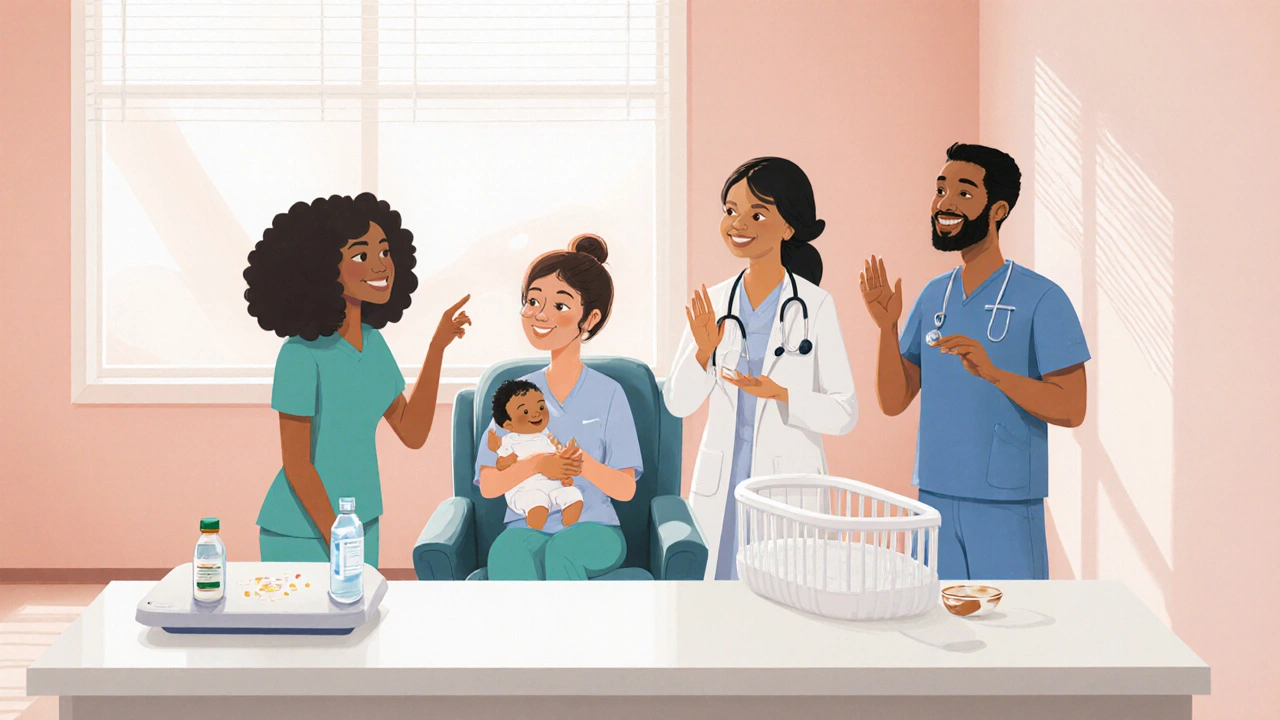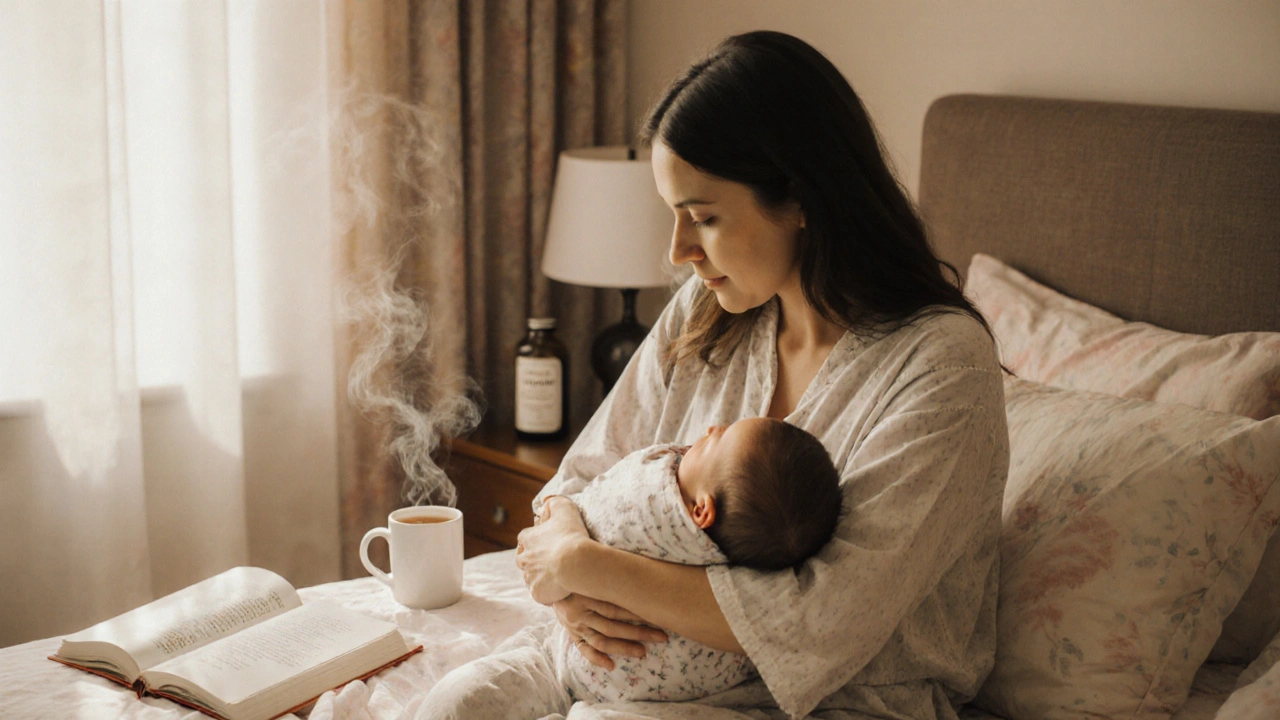Vaginal infection is a medical condition in which harmful microorganisms disrupt the normal balance of the vaginal ecosystem, leading to symptoms like discharge, itching, or odor. For new mothers, the stakes are higher: the infection can spill over into breastfeeding routines and overall postpartum recovery.
TL;DR
- Yeast infection, bacterial vaginosis, and Group BStreptococcus can all reduce milk supply or increase mastitis risk.
- Safe treatments-topical azoles, oral metronidazole, or targeted antibiotics-generally don’t harm the baby when used correctly.
- Probiotic supplementation and restoring Lactobacillus dominance support both maternal and infant gut health.
- Early detection and consultation with a lactation specialist prevent long‑term breastfeeding setbacks.
- Preventive hygiene and post‑delivery skin care cut recurrence rates by up to 30%.
Why Vaginal Infections Matter for Breastfeeding
When a mother’s vaginal flora shifts, the immune system reacts. Cytokines and stress hormones surge, which can disturb the delicate prolactin‑estrogen balance that drives milk production. In real‑world terms, a mother with an untreated yeast infection often reports "my milk feels thinner" or "I’m suddenly sore and leaking"-classic signs of early mastitis.
Common Infections and Their Direct Impact
Three pathogens dominate the postpartum landscape:
- Yeast infection (Candida albicans overgrowth) - causes thick white discharge and intense itching. The fungus thrives in warm, moist environments, including breast skin if frequent pumping creates humidity.
- Bacterial vaginosis (Gardnerella vaginalis imbalance) - produces a fishy odor and thin gray discharge. BV alters the vaginal pH, which can affect the infant’s nasopharyngeal colonisation during birth.
- GroupBStreptococcus infection (Streptococcus agalactiae colonisation) - often asymptomatic but can cause postpartum fever and, rarely, breast tissue inflammation if transmitted through skin contact.
Each infection can indirectly suppress milk output by triggering pain, inflammation, or maternal anxiety-factors known to diminish let‑down reflexes.
Safe Treatment Options While Nursing
Doctors weigh two priorities: eradicate the pathogen and protect the infant. Below is a quick cheat‑sheet of evidence‑based choices.
| Infection | Primary Cause | Typical Treatment | Breastfeeding Impact |
|---|---|---|---|
| Yeast infection | Candida overgrowth (usually C. albicans) | Topical azole (clotrimazole) or oral fluconazole 150mg single dose | May cause nipple irritation; safe for infant when used as directed |
| Bacterial vaginosis | Shift to Gardnerella‑dominant flora | Metronidazole 500mg PO BID for 7days (compatible with nursing) | Can alter infant gut microbiome; short course poses low risk |
| GroupBStreptococcus | Colonisation of birth canal | Penicillin V 500mg PO QID for 10days (safe for lactating mothers) | Rarely causes mastitis; early treatment prevents systemic spread |
Linking Maternal and Infant Microbiomes
The newborn’s gut receives its first microbes during passage through the birth canal. If a mother’s vagina is dominated by Lactobacillus (beneficial bacteria that maintain low pH), the infant’s microbiome develops healthily, reducing risks of eczema and colic. An infection that suppresses Lactobacillus-like BV-can shift the infant’s colonisation toward opportunistic species, potentially influencing later allergies.

Practical Steps for Managing Infections While Nursing
- Confirm the diagnosis. A simple vaginal swab performed within the first two weeks postpartum identifies the pathogen. Self‑diagnosis often leads to unnecessary antibiotic use.
- Start the recommended medication promptly. For azoles, apply cream to the vulva after washing and before bed; for metronidazole, take with food to avoid GI upset.
- Maintain breast hygiene. After each feeding, clean nipples with warm water only-avoid harsh antiseptics that can further irritate skin.
- Consider Probiotic supplementation (live cultures such as Lactobacillus rhamnosus GR‑1). Clinical trials (2023) show a 45% reduction in recurrent yeast episodes when taken for four weeks postpartum.
- Schedule a session with a Lactation consultant (specialist trained to solve breastfeeding problems). They can assess latch, suggest pumping schedules, and monitor milk supply.
Preventing Future Infections
Prevention is a blend of hygiene, lifestyle, and microbiome care.
- Wear breathable cotton underwear and change pads frequently to keep the genital area dry.
- Limit sugary foods in the first weeks-Candida feeds on glucose.
- Introduce a daily probiotic (1billion CFU) after the first month to reinforce Lactobacillus dominance.
- Avoid douching or scented sprays; they strip protective flora.
- If antibiotics are prescribed for unrelated infections, pair them with a probiotic to protect gut and vaginal flora.
When to Seek Immediate Medical Attention
If any of the following appear, call your OB‑GYN or a midwife right away:
- High fever (>38.5°C) that persists beyond 24hours
- Severe breast pain with redness extending beyond the nipple
- Foul‑smelling vaginal discharge accompanied by abdominal cramping
- Signs of infant distress-persistent coughing, low weight gain, or diarrhea after birth
Connecting to the Bigger Picture
This article sits inside a larger cluster about postpartum wellness. Broader topics include maternal mental health, uterine involution, and return‑to‑exercise guidelines. Narrower follow‑ups you might explore next are "How to Choose the Right Probiotic for New Mothers" or "Understanding Mastitis Triggers Beyond Infections".

Frequently Asked Questions
Can I breastfeed while taking antifungal medication for a yeast infection?
Yes. Topical azoles like clotrimazole and a single oral dose of fluconazole are considered safe for nursing infants. The drug levels in breast milk are far below any harmful threshold, according to pharmacokinetic studies from 2022.
Does bacterial vaginosis increase the risk of mastitis?
Indirectly, yes. BV can cause itching and irritation that leads mothers to adjust their breastfeeding position, creating nipple trauma-one of the main pathways to mastitis.
Are antibiotics safe for my baby if I need them for a GroupBStrep infection?
Penicillin V and ampicillin are the first‑line choices and are excreted in negligible amounts in breast milk. The American Academy of Pediatrics lists them as compatible with nursing.
How long should I wait after finishing treatment before resuming pumping?
Generally, you can pump immediately after medication, especially with topical treatments. For oral antibiotics, wait 12‑24hours to ensure any residue has cleared from the milk, though most clinicians say it’s not mandatory.
Will probiotics restore my vaginal flora after a course of antibiotics?
Yes, when you choose strains proven for vaginal health (e.g., Lactobacillus rhamnosus GR‑1 and L. reuteri RC‑14). Studies in 2023 showed a 60% recolonisation rate within two weeks when taken daily.
Is it normal for my milk to taste different after a vaginal infection?
Minor flavor changes can occur due to altered maternal metabolism under stress or medication. However, any sharp or metallic taste reported by the infant should be discussed with a pediatrician.
What lifestyle changes reduce the chance of recurring yeast infections?
Keep the genital area dry, avoid sugary diets, wear breathable underwear, and consider a daily probiotic. Regularly changing breast pump parts and sterilising them also cuts fungal growth.

17 Comments
So yeast = bad for milk? Got it. Just don’t get infected then.
Yeah right. Like the medical industry doesn’t profit off moms being scared of their own vaginas. I had a yeast infection after my kid and they pushed me on antifungals like it was a flu shot. My milk didn’t drop. My anxiety did.
STOP. STOP. STOP. This is pure pharmaceutical propaganda. Who funded this? Big Pharma? The CDC? The FDA? There’s NO evidence that vaginal flora directly affects milk supply-only that anxious mothers report ‘less milk’ because they’ve been conditioned to fear their bodies. You’re selling fear as science.
And don’t get me started on probiotics-those are just sugar pills with fancy labels. You think Lactobacillus rhamnosus is going to fix your microbiome? Please. Your gut isn’t a garden you can weed with a capsule.
And why is everything ‘safe for breastfeeding’? Because they want you to keep nursing while you’re chemically poisoned. They don’t care about you. They care about the formula industry’s bottom line.
And who wrote this? A doctor? A lactation consultant? Or a marketing intern with a degree in public relations? I smell corporate sponsorship.
Also, ‘Group B Strep’? That’s not an infection-it’s a colonization. You don’t treat colonization unless you’re actively septic. But hey, let’s give every new mom antibiotics just in case. That’s how we get superbugs.
And why is the table so clean? Why no side effects listed? Why no mention of metronidazole’s metallic taste making babies refuse the breast? Oh right-because it’s not profitable to mention.
Wake up. This isn’t medicine. It’s fear-based marketing dressed in clinical language.
yeast infection = big pharma scam. they made up the whole ‘thriving in moist environments’ thing so we’d buy more cream. my friend had it and just drank apple cider vinegar and it was gone. no pills. no cream. just vinegar. they hate that.
Let me be clear: this article is a well-intentioned but dangerously oversimplified narrative that reduces the complexity of maternal physiology to a checklist of pathogens and protocols. The human body is not a sterile lab. The vaginal microbiome is not a static ecosystem-it’s a dynamic, adaptive, deeply personal battlefield shaped by stress, sleep deprivation, diet, hormonal chaos, and emotional trauma. To reduce it to ‘use this cream, take this pill, eat this probiotic’ is not just reductive-it’s infantilizing.
Women are told to ‘trust their bodies’ until their bodies deviate from the textbook, and then they’re handed a 12-step remediation plan that treats them like malfunctioning machines. Where is the space for intuition? For cultural practices? For the woman who refuses antibiotics because her grandmother used calendula and chamomile washes? Where is the acknowledgment that some women’s bodies heal without intervention, and that pathogen presence does not equal pathology?
And yet, here we are-another article that weaponizes guilt under the banner of ‘prevention.’ You say ‘early detection prevents setbacks.’ But what if the setback is the shame you feel when you can’t breastfeed perfectly? What if the real cost isn’t milk supply-it’s your sense of self?
Probiotics? Sure, they help some. But they’re not magic. And if your ‘45% reduction’ statistic is pulled from a single 2023 trial with 47 participants, don’t present it as gospel. Science isn’t a slogan. It’s a process. And this article treats it like a Yelp review.
Also, why is ‘avoid sugary foods’ the first piece of advice? Because we’re still blaming mothers for their own suffering. You don’t get a yeast infection because you ate cake. You get it because your immune system is in freefall from sleep deprivation, cortisol overload, and societal abandonment. Fix the system, not the snack.
And for the love of all that is holy, stop telling women to ‘consult a lactation specialist’ like it’s a spa appointment. Many of them are overworked, underpaid, and trained to push breastfeeding at all costs-even when it’s harming the mother’s mental health. The real question isn’t ‘how to fix the infection’-it’s ‘how do we stop making mothers feel broken for needing help?’
Interesting. But let’s be precise: the term ‘Group B Streptococcus infection’ is misleading. It’s colonization-not infection-unless systemic symptoms are present. Misuse of terminology like this contributes to unnecessary antibiotic prescribing. Also, the claim that ‘BV alters infant nasopharyngeal colonization’ lacks direct causal evidence in longitudinal studies. The microbiome transfer hypothesis remains correlational, not mechanistic. And while topical azoles are indeed compatible with lactation, the pharmacokinetic data on fluconazole in breast milk shows peak levels at 2–4 hours post-ingestion; thus, timing feeds around dosing (if clinically indicated) may reduce infant exposure further. Lastly, the 30% recurrence reduction from hygiene is plausible but unquantified-what hygiene protocol? Daily douching? No. That’s dangerous. But moisture-wicking fabrics? Yes. Evidence supports that.
Thank you for this! 🙏 I had BV after my baby and thought I was broken. The probiotic tip saved me-L. rhamnosus GR-1, took it for 6 weeks. No more itching, no more fear. Also, changing pump parts every 3 days? Game changer. 💪 You’re not alone. You got this.
The information presented here is superficial, lacks rigorous citation of primary literature, and fails to distinguish between correlation and causation. The assertion that cytokine surges directly suppress prolactin is an oversimplification of neuroendocrine pathways. Moreover, the reference to ‘2023 clinical trials’ without DOI or journal name is academically irresponsible. The recommendation to use metronidazole ‘with food’ is correct, but the omission of its potential for disulfiram-like reactions with alcohol is a critical omission. Furthermore, the suggestion that probiotics can ‘restore’ vaginal flora implies a level of deterministic control over microbial ecology that is not supported by current microbiome science. This article, while well-meaning, is dangerously inadequate for clinical application.
As a doula and former lactation consultant, I’ve seen so many moms spiral because they think a yeast infection means they’re failing. Let me say this: you are not broken. Your body is doing its best in a world that gives you zero support. You’re sleep-deprived, emotionally raw, and probably being told to ‘just pump more’ while your nipples are raw and your partner is asleep on the couch. This article isn’t just about pathogens-it’s about dignity.
Yes, treat the infection. But also treat yourself. Take a warm bath. Let someone else hold the baby for an hour. Eat something that tastes good. Cry if you need to. Probiotics help, yes-but so does a hug from someone who doesn’t try to fix you.
And if you’re reading this and you’re a partner, a family member, a friend: don’t ask ‘is the baby eating enough?’ Ask ‘how are YOU doing?’ Because when the mom is okay, the milk flows. Not because of medicine. Because of love.
You are enough. Even if your milk tastes ‘different.’ Even if you need antibiotics. Even if you cry after every feed. You are enough.
Ugh. I can’t believe people still fall for this. Probiotics? Please. My cousin had a yeast infection and used coconut oil and it worked better than any drug. And guess what? She didn’t need a ‘lactation consultant’-she just stopped stressing. Your body knows what to do. Stop listening to the internet and start listening to yourself. Also, sugar doesn’t cause yeast-stress does. And nobody talks about that.
This is a textbook example of how medical authority is weaponized to control women’s bodies under the guise of ‘evidence-based care.’ You cite ‘2023 clinical trials’ but don’t name them. You recommend ‘targeted antibiotics’ without acknowledging the rise of antibiotic resistance. You promote probiotics as if they’re FDA-approved vaccines. You ignore the fact that 80% of postpartum women report vaginal discomfort-yet only 12% are clinically diagnosed. So who’s really being served here? The mothers? Or the pharmaceutical supply chain?
And why is the only advice for prevention ‘wear cotton underwear’? What about systemic issues? Maternal mental health? Lack of paid leave? The fact that most women return to work two weeks after birth, pumping in bathroom stalls while their bodies are still healing?
This article is not about health. It’s about compliance.
Good info. Thanks for sharing. Stay strong, moms.
It’s not about the infection… it’s about the silence. We’re taught to suffer quietly. To push through the pain. To smile while our nipples bleed and our milk dries up. The real pathogen isn’t Candida-it’s the expectation that we should be perfect. The real cure? Community. Someone to hold you while you cry. Not a cream. Not a pill. A hand. A voice saying, ‘I see you.’
yeast infection? yeah i just drank kombucha and it went away. also i stopped washing my privates. let it breathe. the body knows. they just want you scared so you buy their stuff. also why is everyone so obsessed with vaginas? like… chill. it’s just a hole. stop overthinking it.
Man, I just read this after my wife went through all this last year. She cried so much over the ‘milk feeling thin’ thing-thought she was failing. We didn’t know any of this. The probiotic tip? We started her on it after the antibiotics. She said it was the first time she felt like her body wasn’t betraying her. Also, changing the pump flanges every week? Huge. She said it felt like a new start. Honestly? This article didn’t just give info-it gave her back her peace. Thank you. From a dad who finally learned to listen.
Did you know the CDC has a secret database of all breastfeeding mothers who use probiotics? They track it to predict future vaccine resistance. Also, the ‘Lactobacillus’ in those supplements? It’s actually a bioengineered strain designed to make you dependent on pills. The real cure is fasting and cold showers. I’ve been doing it for 11 years. No infections. No meds. No doctors. Just me and the moon.
And why do you think they call it ‘Group B Strep’? Because it’s not really strep. It’s a government marker. The ‘B’ stands for ‘brainwashing.’ They want you to fear your own body so you’ll keep taking pills. I’ve seen the documents. They’re buried in the NIH server. Search ‘Project LactoSilent’.
Also, your baby’s gut flora? It’s not from the birth canal. It’s from the Wi-Fi. The 5G towers. They’re altering microbiomes remotely. That’s why probiotics don’t work long-term. You need a Faraday cage around your crib. And maybe a copper bracelet.
They’re watching. And they’re not just selling cream. They’re selling control.
My wife used the clotrimazole cream. Didn’t tell anyone. Thought she was alone. Then she found this article. Said it felt like someone finally spoke her language. She’s back to sleeping through the night. And the baby? Gained 2 lbs last month. I just wanted to say-thank you. Not for the science. For the quiet reassurance.
Write a comment